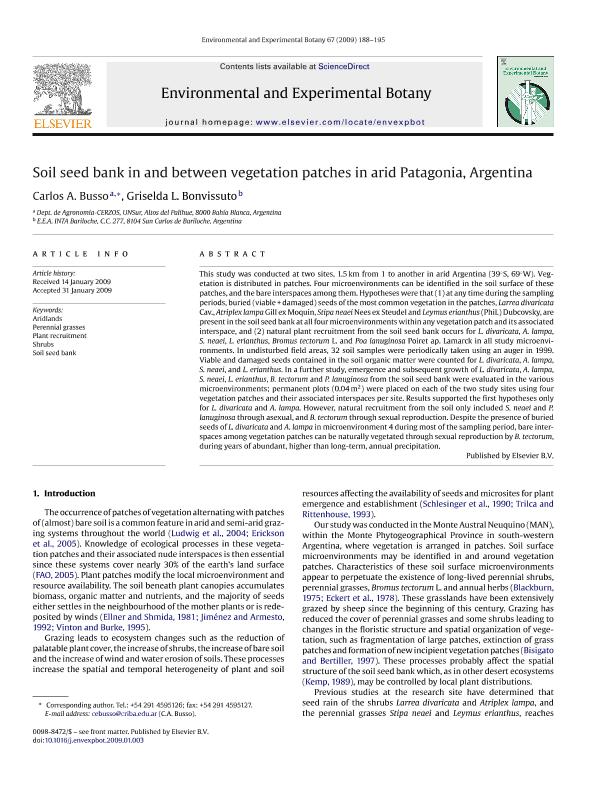Mostrar el registro sencillo del ítem
dc.contributor.author
Busso, Carlos Alberto

dc.contributor.author
Bonvissuto, Griselda Luz

dc.date.available
2017-10-19T15:12:34Z
dc.date.issued
2009-02
dc.identifier.citation
Busso, Carlos Alberto; Bonvissuto, Griselda Luz; Soil seed bank in and between vegetation patches in arid Patagonia, Argentina; Elsevier Science; Environmental and Experimental Botany; 67; 1; 2-2009; 188-195
dc.identifier.issn
0098-8472
dc.identifier.uri
http://hdl.handle.net/11336/26803
dc.description.abstract
This study was conducted at two sites, 1.5 km from 1 to another in arid Argentina (39◦S, 69◦W). Vegetation is distributed in patches. Four microenvironments can be identified in the soil surface of these patches, and the bare interspaces among them. Hypotheseswere that (1) at any time during the sampling periods, buried (viable + damaged) seeds of the most common vegetation in the patches, Larrea divaricata Cav., Atriplex lampa Gill ex Moquin, Stipa neaeiNees ex Steudel and Leymus erianthus (Phil.) Dubcovsky, are present in the soil seed bank at all four microenvironments within any vegetation patch and its associated interspace, and (2) natural plant recruitment from the soil seed bank occurs for L. divaricata, A. lampa, S. neaei, L. erianthus, Bromus tectorum L. and Poa lanuginosa Poiret ap. Lamarck in all study microenvironments. In undisturbed field areas, 32 soil samples were periodically taken using an auger in 1999. Viable and damaged seeds contained in the soil organic matter were counted for L. divaricata, A. lampa, S. neaei, and L. erianthus. In a further study, emergence and subsequent growth of L. divaricata, A. lampa, S. neaei, L. erianthus, B. tectorum and P. lanuginosa from the soil seed bank were evaluated in the various microenvironments; permanent plots (0.04m2) were placed on each of the two study sites using four vegetation patches and their associated interspaces per site. Results supported the first hypotheses only for L. divaricata and A. lampa. However, natural recruitment from the soil only included S. neaei and P. lanuginosa through asexual, and B. tectorum through sexual reproduction. Despite the presence of buried seeds of L. divaricata and A. lampa in microenvironment 4 during most of the sampling period, bare interspaces among vegetation patches can be naturally vegetated through sexual reproduction by B. tectorum, during years of abundant, higher than long-term, annual precipitation.
dc.format
application/pdf
dc.language.iso
eng
dc.publisher
Elsevier Science

dc.rights
info:eu-repo/semantics/openAccess
dc.rights.uri
https://creativecommons.org/licenses/by-nc-sa/2.5/ar/
dc.subject
Aridlands
dc.subject
Perennial Grasses
dc.subject
Plant Recruitment
dc.subject
Shrubs
dc.subject
Soil Seed Bank
dc.subject.classification
Otras Agricultura, Silvicultura y Pesca

dc.subject.classification
Agricultura, Silvicultura y Pesca

dc.subject.classification
CIENCIAS AGRÍCOLAS

dc.title
Soil seed bank in and between vegetation patches in arid Patagonia, Argentina
dc.type
info:eu-repo/semantics/article
dc.type
info:ar-repo/semantics/artículo
dc.type
info:eu-repo/semantics/publishedVersion
dc.date.updated
2017-10-09T15:30:50Z
dc.journal.volume
67
dc.journal.number
1
dc.journal.pagination
188-195
dc.journal.pais
Países Bajos

dc.journal.ciudad
Amsterdam
dc.description.fil
Fil: Busso, Carlos Alberto. Consejo Nacional de Investigaciones Científicas y Técnicas. Centro Científico Tecnológico Conicet - Bahía Blanca. Centro de Recursos Naturales Renovables de la Zona Semiárida. Universidad Nacional del Sur. Centro de Recursos Naturales Renovables de la Zona Semiárida; Argentina
dc.description.fil
Fil: Bonvissuto, Griselda Luz. Instituto Nacional de Tecnología Agropecuaria. Centro Regional Patagonia Norte. Estación Experimental Agropecuaria San Carlos de Bariloche; Argentina. Consejo Nacional de Investigaciones Científicas y Técnicas; Argentina
dc.journal.title
Environmental and Experimental Botany

dc.relation.alternativeid
info:eu-repo/semantics/altIdentifier/doi/http://dx.doi.org/10.1016/j.envexpbot.2009.01.003
dc.relation.alternativeid
info:eu-repo/semantics/altIdentifier/url/http://www.sciencedirect.com/science/article/pii/S009884720900029X
Archivos asociados
